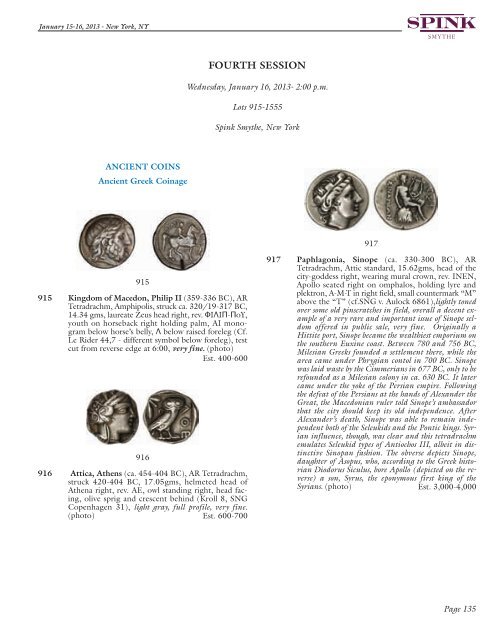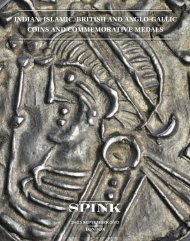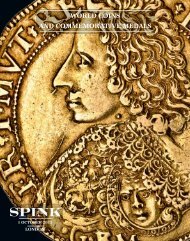Create successful ePaper yourself
Turn your PDF publications into a flip-book with our unique Google optimized e-Paper software.
January 15-16, 2013 - New York, NY<br />
FOURTH SESSION<br />
Wednesday, January 16, 2013- 2:00 p.m.<br />
Lots 915-1555<br />
<strong>Spink</strong> Smythe, New York<br />
ANCIENT COINS<br />
Ancient Greek Coinage<br />
917<br />
915<br />
915 Kingdom of Macedon, Philip II (359-336 BC), AR<br />
Tetradrachm, Amphipolis, struck ca. 320/19-317 BC,<br />
14.34 gms, laureate Zeus head right, rev. ΦIΛIΠ-ΠoY,<br />
youth on horseback right holding palm, AI monogram<br />
below horse’s belly, Λ below raised foreleg (Cf.<br />
Le Rider 44,7 - different symbol below foreleg), test<br />
cut from reverse edge at 6:00, very fine. (photo)<br />
Est. 400-600<br />
916<br />
916 Attica, Athens (ca. 454-404 BC), AR Tetradrachm,<br />
struck 420-404 BC, 17.05gms, helmeted head of<br />
Athena right, rev. AE, owl standing right, head facing,<br />
olive sprig and crescent behind (Kroll 8, SNG<br />
Copenhagen 31), light gray, full profile, very fine.<br />
(photo) Est. 600-700<br />
917 Paphlagonia, Sinope (ca. 330-300 BC), AR<br />
Tetradrachm, Attic standard, 15.62gms, head of the<br />
city-goddess right, wearing mural crown, rev. INEN,<br />
Apollo seated right on omphalos, holding lyre and<br />
plektron, A-M-T in right field, small countermark “M”<br />
above the “T” (cf.SNG v. Aulock 6861),lightly toned<br />
over some old pinscratches in field, overall a decent example<br />
of a very rare and important issue of Sinope seldom<br />
offered in public sale, very fine. Originally a<br />
Hittite port, Sinope became the wealthiest emporium on<br />
the southern Euxine coast. Between 780 and 756 BC,<br />
Milesian Greeks founded a settlement there, while the<br />
area came under Phrygian contol in 700 BC. Sinope<br />
was laid waste by the Cimmerians in 677 BC, only to be<br />
refounded as a Milesian colony in ca. 630 BC. It later<br />
came under the yoke of the Persian empire. Following<br />
the defeat of the Persians at the hands of Alexander the<br />
Great, the Macedonian ruler told Sinope’s ambassador<br />
that the city should keep its old independence. After<br />
Alexander’s death, Sinope was able to remain independent<br />
both of the Seleukids and the Pontic kings. Syrian<br />
influence, though, was clear and this tetradrachm<br />
emulates Seleukid types of Antiochos III, albeit in distinctive<br />
Sinopan fashion. The obverse depicts Sinope,<br />
daughter of Asopus, who, according to the Greek historian<br />
Diodorus Siculus, bore Apollo (depicted on the reverse)<br />
a son, Syrus, the eponymous first king of the<br />
Syrians. (photo) Est. 3,000-4,000<br />
Page 135

















